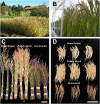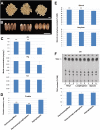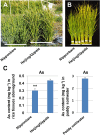Adaptation of Rice to the Nordic Climate Yields Potential for Rice Cultivation at Most Northerly Site and the Organic Production of Low-Arsenic and High-Protein Rice
- PMID: 32425956
- PMCID: PMC7212348
- DOI: 10.3389/fpls.2020.00329
Adaptation of Rice to the Nordic Climate Yields Potential for Rice Cultivation at Most Northerly Site and the Organic Production of Low-Arsenic and High-Protein Rice
Abstract
There is an urgent demand for low-arsenic rice in the global market, particularly for consumption by small children. Soils in Uppsala, Sweden, contain low concentrations of arsenic (As). We hypothesize that if certain japonica paddy rice varieties can adapt to the cold climate and long day length in Uppsala and produce normal grains, such a variety could be used for organic production of low-arsenic rice for safe rice consumption. A japonica paddy rice variety, "Heijing 5," can be cultivated in Uppsala, Sweden, after several years' adaptation, provided that the rice plants are kept under a simple plastic cover when the temperature is below 10°C. Uppsala-adapted "Heijing 5" has a low concentration of 0.1 mg per kg and high protein content of 12.6% per dry weight in brown rice grain, meaning that it thus complies with all dietary requirements determined by the EU and other countries for small children. The high protein content is particularly good for small children in terms of nutrition. Theoretically, Uppsala-adapted "Heijing 5" can produce a yield of around 5100 kg per ha, and it has a potential for organic production. In addition, we speculate that cultivation of paddy rice can remove nitrogen and phosphorus from Swedish river water and reduce nutrient loads to the Baltic Sea and associated algae blooms.
Keywords: Baltic Sea; Uppsala rice cultivation; high-protein rice; infant food; low-arsenic rice; rice for cold climate.
Copyright © 2020 Fei, Jin, Jin, Su, Ruan, Wang, Liu and Sun.
Figures




References
-
- Aastrup M., Thunholm B. (2001). Heavy metals in Stockholm groundwater – concentraions and fluxes. Water Air Soil Pollut. Focus 1 25–41.
-
- Access to European Union law (2006). Limitations for Certain Substances in Food (in Swedish). Available online at: https://eur-lex.europa.eu/eli/reg/2006/1881/oj/swe?locale=en (accessed April 17, 2020).
LinkOut - more resources
Full Text Sources
Research Materials

